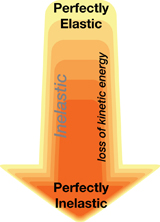Module 2
1. Module 2
1.13. Page 4
Module 2—The Conservation of Momentum in Isolated Systems
The Difference Between Elastic and Inelastic Collisions
In a collision, momentum is always conserved, but kinetic energy is not. Sometimes, the kinetic energy is nearly conserved. In other collisions, it is hardly conserved at all. What is going on?
During a collision, energy changes form. As objects interact and collide, they change shape and are distorted. When this occurs, the kinetic energy of the colliding bodies is converted into potential energy, or dissipated as sound or heat. The extent to which the initial kinetic energy is converted to final kinetic energy during the collision determines the elasticity of the collision.
There is a spectrum of elasticity: collisions can range from being perfectly elastic to perfectly inelastic. As collisions become more and more inelastic, more and more kinetic energy is lost.

Perfectly Elastic Collisions
In a perfectly elastic collision, the total kinetic energy of the system is conserved. Perfectly elastic collisions generally occur only at the subatomic level.
Inelastic Collisions
In an inelastic collision, some kinetic energy is lost, generally as sound or thermal energy. This is a broad range and most collisions fall within this class.
Perfectly Inelastic Collisions
In a perfectly inelastic collision (also called completely inelastic), the colliding objects stick together upon impact. There is the greatest loss of kinetic energy in this type of collision.
 Self-Check
Self-Check
SC 2. Imagine throwing a perfectly spherical bouncy, elastic ball against the wall.
- Describe the shape of the ball before, during, and after the collision.
before: _______ during: __________ after: __________
- Describe what happens to the kinetic energy of the ball during the interaction. Is the kinetic energy of the ball conserved? If not, what happened to it?
SC 3. Imagine throwing a blob of playdough against the wall.
- Describe the shape of the blob before, during, and after the collision.
before: _________during: _____________ after: ____________
- Describe what happens to the kinetic energy of the blob during the interaction. Is the kinetic energy of the blob conserved? If not, what happened to it?
 Self-Check Answers
Self-Check Answers
SC 2.
-
before: spherical during: squished after: spherical
-
The kinetic energy of the ball is nearly conserved, with some kinetic energy being used as work done to momentarily change the shape of the ball.
SC 3.
-
before: blob during: flat after: stays flat
-
The kinetic energy of the playdough is not conserved. Most of the kinetic energy is used in order to change the shape of the playdough permanently.
The Coefficient of Restitution Defines Elasticity
Is there a range of elasticity in the collisions that were performed in the lab? Recall that in each collision, a value known as e was recorded at the top of each table. Now we will examine what the e value represents. Use the lab data tables to complete the Module 2: Lesson 2 Assignment.
 Module 2: Lesson 2 Assignment
Module 2: Lesson 2 Assignment
Remember to submit the answers to A 1 and A 2 to your teacher as part of your Module 2: Lesson 2 Assignment.
A 1. Complete the data table below by doing the following:
a. Record the total ![]() , total
, total ![]() , and e for each collision from the lab data tables.
, and e for each collision from the lab data tables.
b. Calculate the percentage of loss in kinetic energy for each collision using:
![]()
| Collision | e |
Total Ek Initial |
Total Ek Final |
Loss in Ek (%) |
1 |
|
|
|
|
2 |
|
|
|
|
3 |
|
|
|
|
4 |
|
|
|
|
5 |
|
|
|
|
A 2. Using the same data table above, compare the percentage of total kinetic energy lost during each collision to the value of e; e is called the elasticity of the collision. What is the relationship between the percentage of loss in kinetic energy and e?